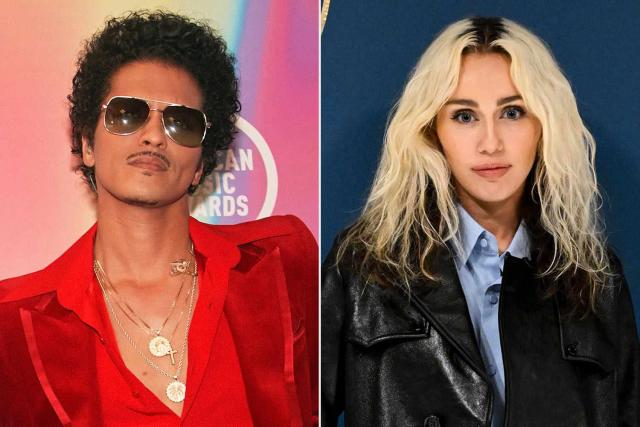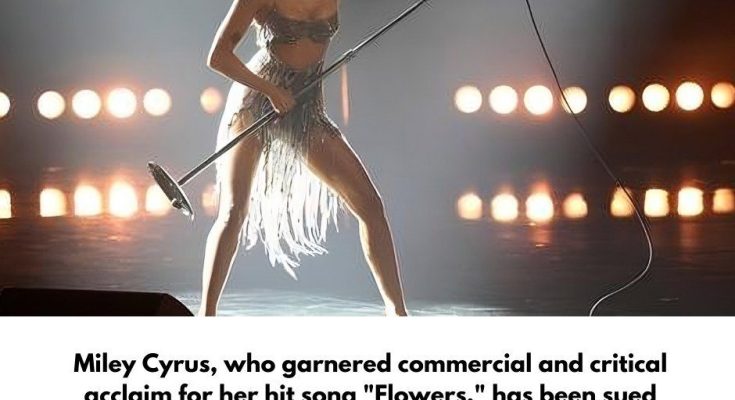Miley Cyrus, one of the most iconic pop stars of her generation, is facing a legal battle over her chart-topping hit song, “Flowers.” The track, which skyrocketed to success upon its release, has been accused of plagiarizing elements from Bruno Mars’ 2013 ballad, “When I Was Your Man.” Filed in a Los Angeles court, this lawsuit claims that Cyrus’ anthem shares significant melodic, harmonic, and lyrical similarities with Mars’ song.
The Lawsuit: A Closer Look at the Accusations
Tempo Music Investments is the entity behind the lawsuit, alleging that Miley Cyrus copied key elements from Bruno Mars’ track “When I Was Your Man.” In the complaint, the company states that several aspects of “Flowers” bear too much resemblance to Mars’ hit to be coincidental.
According to the lawsuit, “Flowers” contains:
- Melodic pitch design and sequence in the verse.
- Bass-line connections that mirror Mars’ composition.
- Chorus elements that echo Mars’ song.
- Theatrical music elements and chord progressions similar to those used in “When I Was Your Man.”
Tempo Music, which acquired part of the copyright to Mars’ song through the catalog of Philip Lawrence (one of the co-writers), argues that these similarities are too glaring to ignore.
The Songs’ Lyrics: Are They Too Similar?
One of the central arguments of the lawsuit lies in the lyrical parallels between “Flowers” and “When I Was Your Man.” Both songs tell stories of love lost and self-reflection, but the way these themes are expressed has raised eyebrows.
In Mars’ emotional ballad, he sings: “I should’ve bought you flowers and held your hand / Shoulda gave you all my hours when I had the chance / Take you to every party, ’cause all you wanted to do was dance / Now my baby’s dancin’, but she’s dancin’ with another man.”
Meanwhile, in “Flowers,” Cyrus sings: “I can buy myself flowers, write my name in the sand / Talk to myself for hours, say things you don’t understand / I can take myself dancing and I can hold my own hand / Yeah, I can love me better than you can.”
Though Cyrus’ lyrics offer a more empowering and independent narrative, the lawsuit points to the fact that both songs center around the imagery of flowers, dancing, and self-realization after a breakup. Tempo Music argues that these thematic similarities, paired with alleged musical overlaps, contribute to the case that Cyrus may have drawn too much inspiration from Mars’ original.
Flowers’ Massive Success and Its Connection to the Lawsuit
There’s no denying that “Flowers” has been one of Miley Cyrus’ most successful songs to date. Released on her ex-husband Liam Hemsworth’s birthday, the song not only dominated the radio but also solidified Cyrus’ comeback to mainstream pop culture.
In the lawsuit, Tempo Music highlights the commercial success of “Flowers” and suggests that this popularity is built, at least in part, on its resemblance to Mars’ track. The legal filing states: “Any fan of Bruno Mars’ ‘When I Was Your Man’ knows that Miley Cyrus’ ‘Flowers’ did not achieve all of that success on its own.”

The lawsuit further claims that the song’s triumph, including multiple Grammy Awards for Record of the Year and Best Pop Solo Performance, has been tainted by these alleged infringements. Interestingly, Mars’ “When I Was Your Man” also garnered Grammy recognition, securing a nomination for Best Pop Solo Performance at the 56th Grammy Awards.
The Legal Landscape of Copyright in Music
Copyright lawsuits are nothing new in the music industry. In recent years, there have been a string of high-profile cases where artists have been accused of copying melodies, chord progressions, or even lyrical content. For instance:
- Robin Thicke and Pharrell Williams were famously sued by the estate of Marvin Gaye over their hit song “Blurred Lines,” which was found to have copied elements of Gaye’s “Got to Give It Up.”
- Ed Sheeran faced accusations of copying Marvin Gaye’s “Let’s Get It On” for his hit “Thinking Out Loud.”
Copyright law is notoriously complex, especially when it comes to music. While there are only so many musical notes and chord progressions, the legal test typically revolves around whether a “substantial part” of the original work has been copied.
What’s at Stake for Miley Cyrus?

If the lawsuit against Miley Cyrus moves forward and is successful, it could lead to significant financial penalties. In previous cases, damages awarded have been based on the success of the song in question, which means Cyrus could potentially face substantial payouts, given the massive commercial success of “Flowers.”
Additionally, the case could affect Cyrus’ reputation as an artist. While artists often draw inspiration from others, being found guilty of copyright infringement can taint their legacy and raise questions about their creative integrity.
Miley Cyrus and Bruno Mars: Will the Case Hold Up?
As of now, it remains to be seen how strong Tempo Music’s case is against Miley Cyrus. While there are certainly some thematic and musical similarities between “Flowers” and “When I Was Your Man,” copyright cases can be challenging to win. The line between inspiration and infringement is often blurred, and courts must consider a variety of factors before making a decision.

Ultimately, both Cyrus and Mars are globally recognized artists with distinct styles, and this case will likely explore whether the resemblances are a coincidence or something more deliberate.
Conclusion: The Future of the Case
As the lawsuit progresses, the music industry will be watching closely to see how the Cyrus vs. Mars battle unfolds. The case touches on the broader issue of creativity in music, raising questions about where inspiration ends and plagiarism begins.
For now, Miley Cyrus’ “Flowers” continues to thrive, but the outcome of this legal challenge could shape how future artists approach songwriting and originality. Regardless of the result, this lawsuit highlights the ongoing struggle within the music world over intellectual property and the fine line between creativity and copyright infringement.



